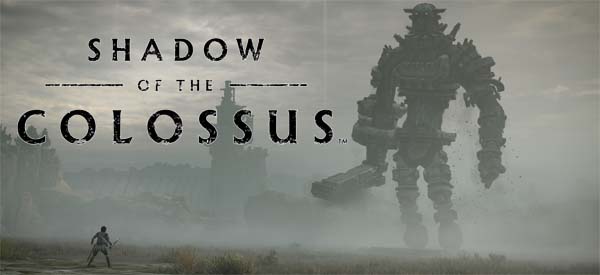
I debated whether to turn this into a retro review of Shadow of the Colossus, or to focus this review on whether or not this particular remake manages to re-capture the magic of the original. Honestly though, what could I possibly say about Shadow of the Colossus that hasn't already said? I might as well try to write a retro review of Citizen Kane or Hamlet!
The original game (released in 2005 by Fumito Ueda's Team Ico at Sony) is a classic and a masterpiece of interactive art. It ranks right up there with games like Portal, Half-Life, Super Mario Bros., and Tetris as a contender for the title of "best video game ever made". Virtually every creative decision that the original team made was the absolute perfectly right decision to make. From the desolate and bleak, yet hauntingly-beautiful landscape. To the immense sens of scale and grandeur that embodies almost every crevice of the game and the sheer smallness of the protagonist himself. To the intimidating, yet majestic aesthetic design of the colossi themselves. To the bittersweet death animations of the Colossi, accompanied by Kow Otani's outstanding score, that makes you question the rightness of your actions. To the way that Agro's independent actions, slightly imprecise controls, and occasional insubordination sell the idea that she's an autonomous living character, rather than a simple vehicle that you pilot as an extension of the player avatar. To the decision to not drag down the game's pace or pollute the overworld with a single encounter with grunt enemies. And on and on...
Shadow of the Colossus was like a digital vacation when it was released in 2005.
It's as perfect a video game as has ever been made. It's the centerpiece of any "games as art" argument (if we still even have to have that argument anymore). Critics and analysts before me have already consecrated Shadow of the Colossus far beyond my petty powers to add or detract.
Bluepoint is the masters of remasters and remakes
Why couldn't Bluepoint have done
the Silent Hill HD Collection?!
Because of how absolutely brilliant the original game is, I had reservations about any attempt to remaster or remake it, especially after the debacle that was Hijinx Studios' Silent Hill HD Collection. Fortunately, however, the remake privilege (or burden, depending on how you want to look at it) was given to Bluepoint Games, the veritable masters of remasters and HD collections. Bluepoint had already released an HD remaster of Shadow of the Colossus on the PS3 back in 2011. I never played it because I thought the PS2 version of the game still looked fantastic and didn't need to be remastered to be enjoyed. That HD remaster was very well-received by the general public, as have been all of Bluepoint's remasters, as far as I am aware. Why couldn't Konami have given Silent Hill to these folks?! [More]
a697dbc5-0ae9-4d08-b310-36e7131bc0ae|2|5.0
Tags:Shadow of the Colossus, Bluepoint Games, Team Ico, Fumito Ueda, Kow Otani, PlayStation 2, PlayStation 4, remake, remaster, colossus, open world, puzzle, platformer, horse, Agro, Wander, Dormin, trophy
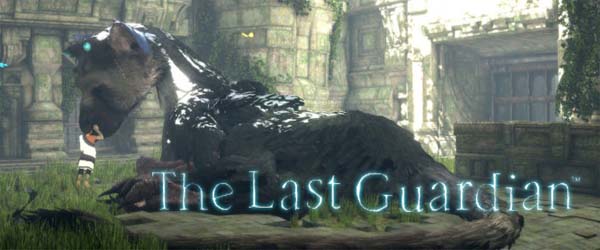
Being the follow-up to a masterpiece is no small order. Being the follow-up to two masterpieces is a Sisyphean task. Ico is a masterpiece of its time. Fumito Ueda and SIE Japan managed to follow that game with Shadow of the Colossus - a masterpiece of even higher order. The bar was set tremendously high for the team's third project: The Last Guardian. Multiple delays, a change in platform from PS3 to PS4, and Fumito Ueda's departure from Sony squashed a lot of the hype for the game. Might the game turn into vaporware? Or might it release in a condition analogous to Metal Gear Solid V?
On the surface, The Last Guardian comes off as being a mash-up of Ico and Shadow of the Colossus. Superficially, it's much more in-line with Ico: you play as a small boy who must guide a companion through a maze of environmental platformer obstacles and adventure puzzles. The catch this time around is that the companion happens to be a giant animal that you can climb and ride on.
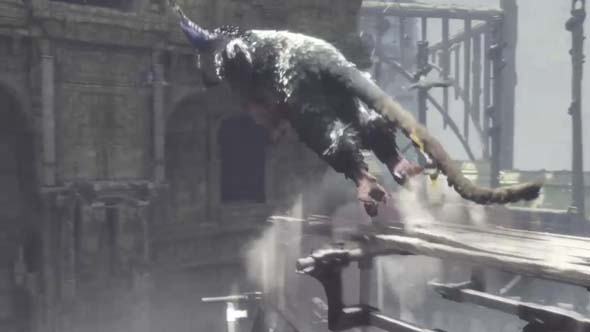
The Last Guardian share more with Ico, but your companion is a giant creature that you climb and ride on.
The big difference though, is that The Last Guardian is sort of an inversion of the gameplay of Ico. In Ico, the player character had to guide a helpless (some even speculated she is blind) princess through a castle and defend her from shadow monsters that try to drag her away. In The Last Guardian, however, it is the player character - the boy - who is mostly helpless. True, you have most of the agency and are guiding Trico through the maze. But Trico is the one with all the power, and your progress is often dependent on Trico getting you past obstacles.
This point is most hammered home by the game's combat mechanics - or rather, its almost complete lack thereof. The boy can't fight off the stone knights that hunt him down. You can only run away, or let Trico smash them into dust for you. If they catch you, they drag you off to a nearby mysterious blue doorway (a parallel to the smokey portals that the smoke monsters dragged Yorda through in Ico), and all you can do is mash buttons to kick and squirm. Ico and Shadow of the Colossus experimented with player agency by making the player question the motivations of the character and wonder if maybe you're doing more harm than good. The Last Guardian toys with agency in other ways. In this game, you, the player, are the helpless tag-along character in an escort quest. You get a glimpse through the eyes of Yorda from Ico or Ashley from Resident Evil 4.
The boy can't fight back, he can only kick and squirm - much like Yorda from Ico.
Not entirely though. The player and Trico make mutual contributions to progress, and their contributions are shared much more than Ico and Yorda. Much like how Yorda could occasionally open the magically-locked doors, the boy in Guardian also has to pull levers and open doors for Trico to pass from room to room. The boy also has to destroy glass eye murals that mesmerize and terrify Trico to the point of paralysis. The boy also hunts down barrels of [supposedly] food for Trico to eat whenever Trico is tired or wounded. But then there's also parts of the game in which the boy simply hops on Trico's back, and Trico leaps away to the next puzzle area without the player having to do anything... [More]
54c716c5-4407-4898-bee0-0725c5a7ce3e|1|5.0
Tags:The Last Guardian, Team Ico, Fumito Ueda, puzzle, platformer, Trico, child, escort quest, Ico, Shadow of the Colossus, PlayStation 4, Sony, exclusive, vaporware, Achievement unlocked
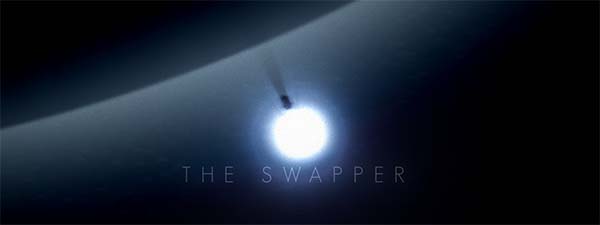
Since I have some extra time off for this holiday season, I'm trying to go through some of my backlog of shorter indie Steam games in between bouts of Cities: Skylines and Beyond Earth: Rising Tide. One such game is Facepalm Games' 2013's sci-fi indie hit, The Swapper, which I picked up in a Steam sale like a year ago. The game has also been ported to many consoles, including the PS3, PS4, Vita, XBox One, and Wii U, and the ports were developed by Curve Digital.
Making my clones do the deadly work
The Swapper seems to owe a lot to Valve's mega-hit Portal. Both games' central mechanics revolve around the player character using a futuristic non-weaponized gun (with 2 settings) to solve platforming puzzles and explore an environment. Portal is in full 3-D, whereas The Swapper is a more traditional 2-D side-scroller. The bigger difference however, is that the gun of The Swapper doesn't fire portable wormholes; instead, it allows the player character to instantly create clones of herself, and to swap her consciousness into one of the clones. Once created, these copies move in tandem with the copy that is currently being controlled by the player. The key to the puzzles is to maneuver yourself so that your clones can reach otherwise inaccessible areas or activate switches.
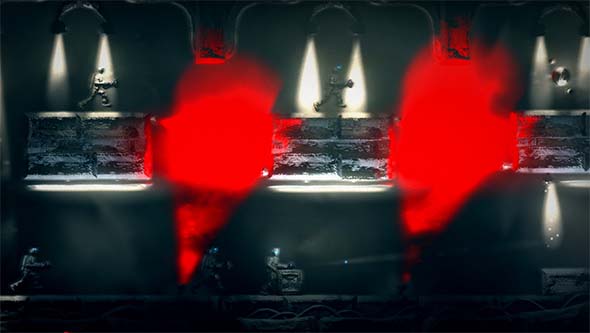
All your clones move in synchronization, making relative spacing very important for solving puzzles.
The space station is laid out in an unbelievable, but serviceable, series of puzzle rooms joined together by modest platforming sections. At first, the platforming between puzzles is interesting because it kept me thinking along the lines of solving puzzles rather than just moving from place to place. But there's a lot of exploration and backtracking, and having to navigate the corridors between puzzle rooms quickly became tedious once using the swapper gun became second nature and automatic. Fortunately, the game provides handy teleporters to allow you to quickly move to key sections of the station, so the backtracking never became as problematic as it could have been.
The puzzles themselves start off fairly simple, requiring that the player simply point the gun and clone herself in order to reach a platform or cross a gap and collect alien orbs that you use to unlock new areas of the space station. The challenge quickly escalates. Soon, obstacles start getting thrown at you, such as colored lights that prevent certain operations of the swapper gun, forcing you to have to find more elaborate ways around the lights in order to reach your destination. You have to start using careful positioning, choreographed movement, gravity, momentum, and inertia in order to successfully solve the puzzles. And all this escalation seems to happen naturally based on the increasing complexity of the levels, rather than through the introduction of new mechanics or controls.
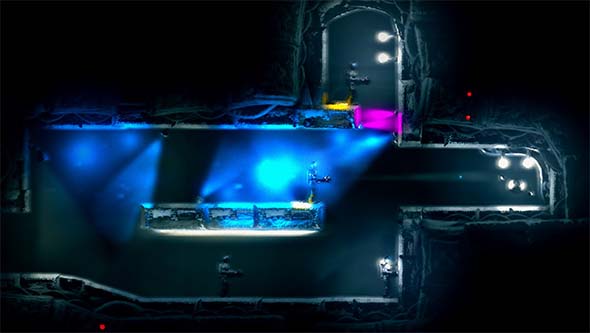
About an hour into the game, I ran into a puzzle that took almost an hour of trial-and-error for me to solve.
About an hour into the game, the difficulty suddenly spiked, and I ran into one puzzle in particular that took me quite a while to figure out. I even had to leave it and come back to it later with a fresh perspective. I thought maybe I was missing some kind of upgrade or needed to learn some technique that the game hadn't tutorialized yet, but that wasn't the case. Eventually, I figured it out, and the solution seemed head-smacking obvious, but I probably spent a good hour on that one puzzle (approximately half of my time with the game, up to that point).
There are also some other sci-fi mechanics such as the occasional zero-g spacewalk, gravity inversion (allowing you to "fall" up and walk on the ceilings), and so on. These all flow fairly seamlessly into the game; although, I did feel that the gravity inversion felt a little unnecessary when it was introduced. After all, the game teaches you fairly early how to use the swapper gun to effectively fly by repeatedly swapping to clones created above you. This "flying", is, however, limited by the number of clones that you can create, and it's still subject to being blocked by colored lights. So gravity inversion felt superficial when introduced as a means of navigating the station. Once the gravity inversion was introduced into the puzzles, though, I recognized its value.
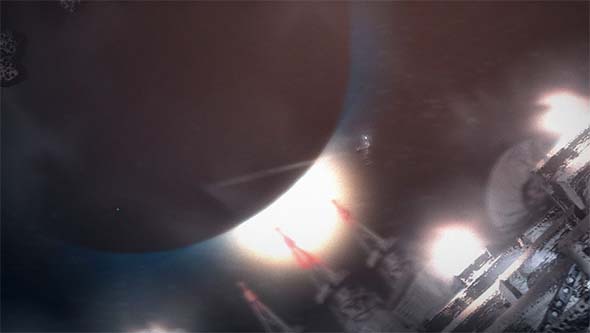
You'll also perform the occasional zero-G spacewalk or invert gravity.
Any problems that I had in solving a puzzle were purely intellectual. Every control and mechanic is intuitive and comfortable, movement is responsive, and I almost never struggled with making the character do what I wanted her to do. All in all, the game plays near-perfectly. The puzzles are appropriately challenging; although, the exploratory nature of the game means that difficulty can wobble back and forth a bit depending on which puzzle rooms you reach first... [More]
8b3a77a8-4dc7-429b-b9ce-44d928af9f86|2|5.0
Tags:The Swapper, Steam, indie gaming, puzzle, platformer, science fiction, cloning, consciousness, identity, self, brain, mind, mind-body problem, space, sentient, alien, Portal

This is a game that caught my attention back in the beginning of the year. I was on the lookout for new horror games to whet my appetite, and the novelty of this little Indie game had me intrigued.
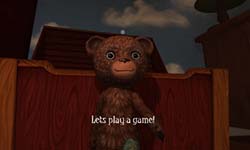
The teddy bear actually comes off as a bit of a creeper at the beginning of the game..
The novelty of Among the Sleep is that the player character is a two-year-old toddler. I actually think that this is a very clever conceit for a horror game. The world can be a very big, scary place for a small child, full of things that are outside of the child's control and beyond the child's understanding. A young child is completely dependent upon its parents or caregiver, which makes them inherently very vulnerable. Unfortunately, since the game is being played by adults, we can't play the game with the ignorance and naivety of a two-year-old, so we would see any real-world environment as exactly what it is: not scary.
So in order for this to work, the designers would have to be very clever in how the environments are presented. Easily he most effective part of the game is the early chapters when the child is lost in a closet and then exploring the house after waking up to find his mother and teddy are absent.
The first person perspective puts the camera very low to the ground, which makes the ordinary environments look large and menacing. The character moves slowly and clumsily (running for more than a few second results in the character falling on his face). Thus, simple hallways seem long and treacherous. Even interactions as simple as opening a door require a small amount of puzzle-solving since the character can't reach a door handle without climbing onto something. This section takes good advantage of the central concept of playing as a toddler by using the legitimate hugeness of the real world, and tapping into our own innate desire to protect and shelter children, in order to make the player feel small and vulnerable.
You even pause the game and access menus by covering your eyes with your hands! Hooray for a lack of object-permanence!
It is a promising start to the game.
But instead of expounding upon this and turning an otherwise mundane environment into an intimidating one, the design quickly shifts into a blatantly-imaginary, whimsical dreamscape. This disconnect from reality suddenly shatters the immersion of the child character, and squanders the inherent novelty of the game's central concept...
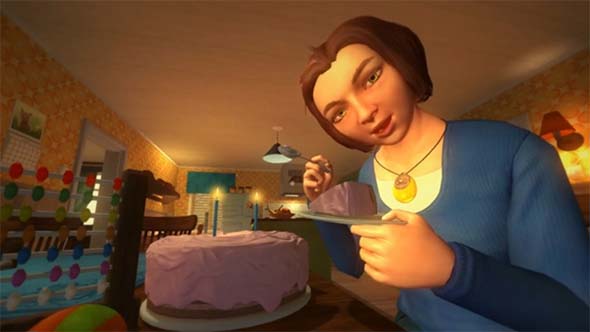
The mother plays an important role in the narrative,
but the player doesn't interact with her long enough to develop any attachment to her. [More]
4aa927f9-d80e-447e-bee0-6fcf21f94621|1|5.0
Tags:Among the Sleep, Krillbite Studio, horror, child, toddler, family, mother, memories, platformer, puzzle, physics, indie gaming, Steam, PC, Unity

Are you as sick of zombies as I am? They're everywhere. Perhaps the real zombie apocalypse won't be caused by radiation or a genetically-engineered plague; it will be caused by media corporations drowning our brains in zombie entertainment until we all go crazy and start eating each other.
Table of Contents
Fungus zombies
OK, sure, the creatures in Naughty Dog's latest adventure game, The Last of Us, aren't actually "zombies", they are humans infected with a fictionalized variation of Ophiocordyceps Unilateralis. But they're functionally the same thing. The "infected", as they are known as in the game, are mindless, mutated monsters that shamble around and eat any human they become aware of. And if they bite you, you become infected and the fungus takes over your brain, turns your flesh into spore-producing tendrils, and makes you a cannibal.
[LEFT] An ant infected with cordyceps.
[CENTER] A moth infected with cordyceps.
[RIGHT] A human infected with cordyceps, as depicted in The Last of Us.
The game takes place 20 years after the sudden outbreak of the human cordyceps infection that leads to the death of the protagonist's daughter. Society has collapsed into ruin, with the surviving 40% of people (including the protagonist, Joel) concentrated in quarantined ghettos in the remains of major cities. Joel is working as a smuggler, bringing food, weapons, and supplies into the Boston quarantine zone to be sold on the black market, and he is tasked with escorting a young girl, named Ellie, to a research lab out west. Ellie is unique in that she seems to be immune to the cordyceps infection. She was bitten weeks ago, and has suffered nothing more than some ugly skin lesions near the bite; whereas, everyone else begins to turn into a zombie within hours of being infected. This, of course, makes her survival paramount, and Joel must do whatever it takes to ensure her safe arrival at the lab so that the researchers can hopefully study her to find a cure or vaccine. [More]
b37fff55-ed98-484c-be2f-cd521976fb05|5|5.0
Tags:The Last of Us, Naughty Dog, Sony, PlayStation 3, PS3, review, action, adventure, platformer, survival, horror, survival horror, Joel, Ellie, cordyceps, fungus, cordie, zombie, ethics, morality, Hippocratic Oath, ludonarrative, Uncharted, Silent Hill 2, Resident Evil 4
|

| 12 | | | | | | | 60 | | 11 | | | | | | | 55 | | 10 | | | | | | | 50 | | 09 | | | | | | | 45 | | 08 | | | | | | | 40 | | 07 | | | | | | | 35 | | 06 | | | | | | | 30 | | 05 | | | | | | | 25 | | 04 | | | | | | | 20 | | 03 | | | | | | | 15 | | 02 | | | | | | | 10 | | 01 | | | | | | | 05 |
|